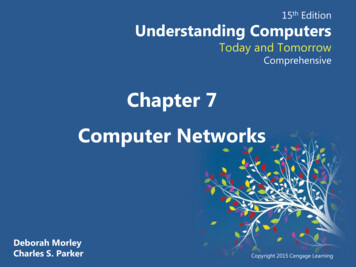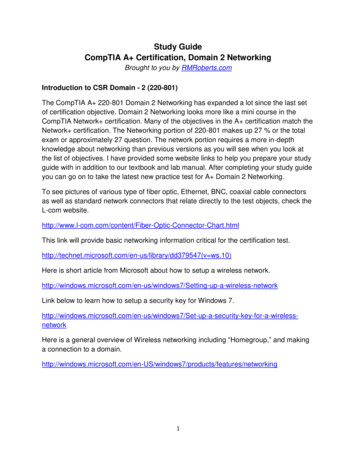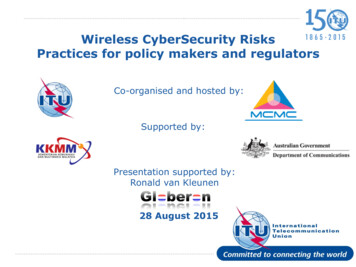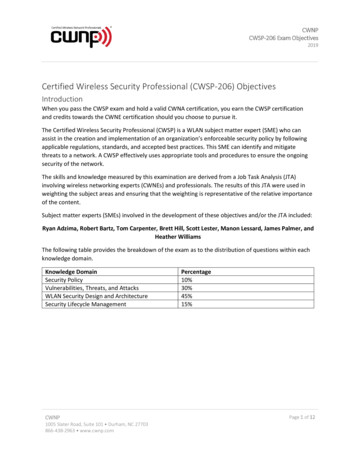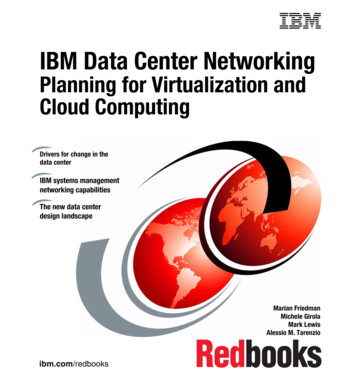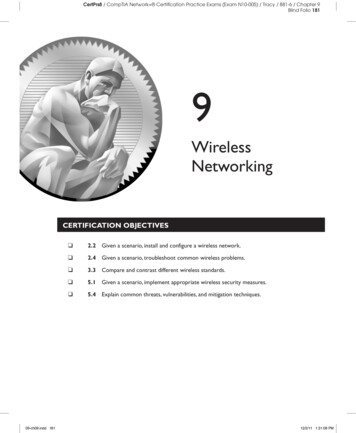
Transcription
CertPrs8 / CompTIA Network Certification Practice Exams (Exam N10-005) / Tracy / 881-6 / Chapter 9Blind Folio 1819WirelessNetworkingCertification Objectives09-ch09.indd 181q2.2 Given a scenario, install and configure a wireless network.q2.4 Given a scenario, troubleshoot common wireless problems.q3.3 Compare and contrast different wireless standards.q5.1 Given a scenario, implement appropriate wireless security measures.q5.4 Explain common threats, vulnerabilities, and mitigation techniques.12/2/11 1:31:08 PM
CertPrs8 / CompTIA Network Certification Practice Exams (Exam N10-005) / Tracy / 881-6 / Chapter 9182Chapter 9: Wireless NetworkingQuestionsWireless networks provide a degree of mobility and flexibility that modern network users demand.However, a wireless network must be implemented correctly to provide adequate performance whilepreventing network security issues. For example, you must manage the placement and power levelof wireless networking components to provide adequate service to your users. At the same time, youmust prevent the signal from leaking outside your organization. In addition, you must implementencryption and authentication mechanisms to ensure that only authorized users are able to access thewireless network.1. You are implementing a wireless network in an office suite. Due to the rectangular shape of thebuilding, you need to implement a single wireless access point in the center of the office suite alongwith four additional wireless access points in each corner. What should you do? (Choose two.)A. Implement a WAP with an omni-directional antenna in the center of the office complex.B. Implement a WAP with a semi-directional antenna in each corner of the office complex.C. Implement a WAP with a highly-directional antenna in the center of the office complex.D. Implement a WAP with a semi-directional antenna in the center of the office complex.E. Implement a WAP with an omni-directional antenna in each corner of the office complex.2. You’ve discovered that the signal from your wireless network is emanating some distance outinto the parking lot of your facility. What can you do to stop this? (Choose three.)A. Implement wireless repeaters at strategic locations within your building.B. Relocate the wireless access point to a central location in your building.C. Increase the gain on the wireless access point antenna.D. Reduce the power level of the wireless access point.E. Implement a Faraday cage on the exterior of your building.F. Implement omni-directional wireless access points.3. Which type of wireless network does not use a wireless access point?A. InfrastructureB. BusC. StarD. Ad hoc4. Which wireless networking standard runs at a frequency of 5 GHz? (Choose two.)A. 802.11aB. 802.11bC. 802.11gD. 802.11nE. 802.11z09-ch09.indd 18212/2/11 1:31:08 PM
CertPrs8 / CompTIA Network Certification Practice Exams (Exam N10-005) / Tracy / 881-6 / Chapter 9Questions1835. You’ve discovered an older laptop in your equipment closet that has in integrated 802.11bwireless network adapter. Your organization uses 802.11n wireless access points to providewireless connectivity to your network. What must you do to connect this device to thenetwork?A. Disable the integrated 802.11b adapter and install an 802.11n USB wireless networkadapter.B. Disable the integrated 802.11b adapter and install an 802.11g USB wireless networkadapter.C. Install a wireless bridge and connect the integrated 802.11b adapter to the 802.11b side ofthe bridge.D. Connect the integrated 802.11b adapter directly to the 802.11n wireless network.6. Which technologies allows the 802.11n standard to provide dramatically more wirelessbandwidth than that available with 802.11b and 802.11g? (Choose two.)A. Lempel-Ziv (LZ) compressionB. Time-division multiplexingC. 3DES data encryptionD. MIMOE. Channel bonding7. You are implementing an 802.11n wireless network for a small business in a rented office suitewithin a large, multitenant office complex. You are experiencing significant interference in thewireless network, causing dropped connections. You’ve discovered that the 2.4 GHz cordlessphone system used in the office is set to use channel 3. You also discovered that neighboringtenants are using channels 1 and 5 for their 802.11x wireless networks. What should you do?A. Set your wireless access point to use channel 2.B. Set your wireless access point to use channel 4.C. Set your wireless access point to use channel 7.D. Set your wireless access point to use channel 3.8. A small business has hired you to manage its 802.11g wireless network. Upon investigation, youfind that 128-bit WEP is being used to secure transmissions on the wireless network. Whichcomponents comprise the encryption keys used on this network? (Choose two.)A. 24-bit initialization vectorB. 40-bit encryption keyC. 48-bit initialization vectorD. 104-bit encryption keyE. 80-bit encryption key09-ch09.indd 18312/2/11 1:31:08 PM
CertPrs8 / CompTIA Network Certification Practice Exams (Exam N10-005) / Tracy / 881-6 / Chapter 9184Chapter 9: Wireless Networking9. Which security standard uses the AES-CCMP algorithm to secure data on a wireless network?A. WEPB. WPA2C. WPAD. WAPI10. You are implementing a new wireless network for a financial services firm. You need to ensurethat the network is as secure as possible. What should you do? (Choose two.)A. Implement WEP encryption on wireless access points and all client systems that willconnect to them.B. Hide the SSID.C. Implement MAC address filtering.D. Implement WPA encryption on wireless access points and all client systems that willconnect to them.E. Use omni-directional antennae on the wireless access points and locate them along theexterior walls of the firm’s physical structure.11. A nefarious individual has used Kismet on his laptop to determine the SSID of a public accessWAP at an airport. Using this information, he has set up a rogue access point and web serveron a laptop within the airport using the same SSID. On the web server, he has created bogusweb pages that look like the pages used by several large banks and credit card companies. Thesepages are used to capture bank and credit card account information and account credentials.What kind of wireless exploit is in use in this scenario?A. Evil twinB. WPA crackingC. War chalkingD. War driving12. Which security weakness is found within the WEP encryption scheme and makes it relativelyeasy to crack?A. The DES encryption used by WEP is relatively easy to crack.B. The RSA encryption used by WEP is relatively easy to crack.C. Short passphrases using words found in the dictionary can be cracked using a dictionary attack.D. The 24-bit IVs are reused and transmitted in clear-text.13. Which mechanism can be used with WPA security to encapsulate Extensible AuthenticationProtocol (EAP) information within an encrypted SSL/TLS tunnel?A. Lightweight Extensible Authentication Protocol (LEAP)B. Protected Extensible Authentication Protocol (PEAP)C. Temporal Key Integrity Protocol (TKIP)D. Extensible Authentication Protocol-MD5 (EAP-MD5)09-ch09.indd 18412/2/11 1:31:08 PM
CertPrs8 / CompTIA Network Certification Practice Exams (Exam N10-005) / Tracy / 881-6 / Chapter 9Questions18514. The wireless users located in a portable office building situated next to your organization’smain physical structure are complaining of slow data transfers over the network. Given thatyour organization uses an 802.11n wireless network with WAPs implemented within the mainphysical structure, what should you do? (Choose two.)A. Implement MAC address filtering.B. Move the users closer to the WAP to see if the signal strength improves.C. Upgrade the users’ computers to 802.11a network interfaces.D. Implement an additional WAP in the location where the users work.E. Change the channel used by the WAP nearest the users to a higher numbered channel.15. Your 802.11n wireless network is experiencing a significant amount of latency. You’ve usedthe IPERF utility to determine that your wireless network is experiencing a significant numberof packets arriving out of order, arriving late, and being completely lost. What should you do?(Choose two.)A. Check for sources of interference, such as microwave ovens or 2.4 GHz cordless phones.B. Verify that all devices on the wireless network are using the correct encryption mechanism.C. Try using a different channel on the WAP to reduce interference from other 2.4 GHz devices.D. Verify that wireless devices are not using mismatched SSIDs.E. Move the WAP’s antenna to a lower physical location.16. A user has reported that he can’t connect to your organization’s 802.11n wireless network fromhis newly issued laptop computer. The user works in a location at which you know a good wirelesssignal is available. In addition, none of his co-workers are having trouble connecting to the wirelessnetwork. The user checked the documentation that came with his laptop and verified that it has anintegrated wireless adapter and that it is enabled. What should you do? (Choose three.)A. Verify that the user is using the correct SSID when connecting.B. Install an 802.11n wireless USB adapter in the laptop.C. Check to see if MAC filtering is in use on the WAP.D. Change the channel used by the WAP to eliminate interference from other 2.4 GHzdevices.E. Check for surfaces or objects that might be causing the wireless network signal to bounce.F. Verify that the user has configured the wireless adapter to use the correct wirelessencryption mechanism.17. Given optimal wireless conditions, which wireless networking standard provides the longest range?A. 802.11aB. 802.11bC. 802.11gD. 802.11n09-ch09.indd 18512/2/11 1:31:08 PM
CertPrs8 / CompTIA Network Certification Practice Exams (Exam N10-005) / Tracy / 881-6 / Chapter 9186Chapter 9: Wireless Networking18. Which wireless networking standard is limited to a maximum bitrate of 11 Mbps?A. 802.11aB. 802.11bC. 802.11gD. 802.11n19. Which wireless security mechanism uses a preshared key (PSK)?A. WEPB. WPA2 EnterpriseC. WPA PersonalD. WAPI20. The Marketing workgroup in your organization decided that they need a stronger wireless signalin their workspace to support the tablet devices they are using to develop a new marketing app.To do this, they purchased a WAP and plugged it into an open network jack within an emptycubicle. Which term best describes the security risk in this scenario?A. Rogue access pointB. Evil twinC. War drivingD. Data emanation09-ch09.indd 18612/2/11 1:31:08 PM
CertPrs8 / CompTIA Security Certification Practice Exams (Exam SY0-301) / Lachance / 120-4 / Chapter 9Quick Answer Key187quick answer key09-ch09.indd 1871.A, B8.A, D15.A, C2.B, D, E9.B16.A, C, F3.D10.B, C17.D4.A, D11.A18.B5.D12.D19.C6.D, E13.B20.A7.C14.B, D12/2/11 1:31:08 PM
CertPrs8 / CompTIA Network Certification Practice Exams (Exam N10-005) / Tracy / 881-6 / Chapter 9188Chapter 9: Wireless NetworkingIn-Depth Answers1. You are implementing a wireless network in an office suite. Due to the rectangular shape of thebuilding, you need to implement a single wireless access point in the center of the office suite alongwith four additional wireless access points in each corner. What should you do? (Choose two.)A. Implement a WAP with an omni-directional antenna in the center of the office complex.B. Implement a WAP with a semi-directional antenna in each corner of the office complex.C. Implement a WAP with a highly-directional antenna in the center of the office complex.D. Implement a WAP with a semi-directional antenna in the center of the office complex.E. Implement a WAP with an omni-directional antenna in each corner of the office complex.3 A and B. The goal of wireless antenna placement is to achieve the best coverage withoutexcessive signal emanation outside the facility. Therefore, an omni-directional antenna inthe center of the rectangular suite would provide the best coverage. Using semi-directionalantennae in each corner would fill in the dead spots left by the omni-directional antennabut reduce signal emanation outside. C, D, and E are incorrect. C and D are incorrect because using a semi- or highly-directionalantenna in the center of the complex would provide poor coverage in a rectangular officesuite. E is incorrect because using omni-directional antennae in each corner of the officewould excessively emanate the wireless signal outside the facility.2. You’ve discovered that the signal from your wireless network is emanating some distance outinto the parking lot of your facility. What can you do to stop this? (Choose three.)A. Implement wireless repeaters at strategic locations within your building.B. Relocate the wireless access point to a central location in your building.C. Increase the gain on the wireless access point antenna.D. Reduce the power level of the wireless access point.E. Implement a Faraday cage on the exterior of your building.F. Implement omni-directional wireless access points.3 09-ch09.indd 188B, D, and E. You could employ several strategies to reduce signal emanation. One is torelocate the WAP to the center of your facility. Another is to reduce the power levelof your WAP. However, depending upon the layout of your building, you may need toimplement additional directional WAPs to cover dead spots created by the reducedsignal strength. Many organizations with very high security requirements implement12/2/11 1:31:09 PM
CertPrs8 / CompTIA Network Certification Practice Exams (Exam N10-005) / Tracy / 881-6 / Chapter 9In-Depth Answers189a metal mesh around the exterior of their buildings to form a Faraday cage that stopssignal emanation completely. However, it will also block cell phone signals. A, C, and F are incorrect. A is incorrect because wireless repeaters would likely increasesignal emanation unless they used directional antennae. C and F are incorrect becausethey would both likely increase signal emanation rather than reduce it.3. Which type of wireless network does not use a wireless access point?A. InfrastructureB. BusC. StarD. Ad hoc3 D. An ad hoc wireless network allows wireless hosts to connect directly to one anotherwithout the use of a WAP. This essentially forms a wireless mesh network topology. A, B, and C are incorrect. A is incorrect because infrastructure wireless networks use a WAP.B is incorrect because wireless Ethernet networks still function as a logical bus, regardless ofwhether they run in infrastructure or ad hoc mode. C is incorrect because a wireless networkthat uses a star topology would require a WAP as a central connecting point.4. Which wireless networking standard runs at a frequency of 5 GHz? (Choose two.)A. 802.11aB. 802.11bC. 802.11gD. 802.11nE. 802.11z09-ch09.indd 1893 A and D. 802.11a is an older wireless networking standard that operates in the 5 GHzfrequency range and transmits data at 54 Mbps. 802.11a devices are incompatible with802.11b and 802.11g devices as these standards all operate in the 2.4 GHz frequencyrange. However 802.11a devices are usually compatible with 802.11n devices, becausethe 802.11n standard operates at either 2.4 or 5 GHz. B, C, and E are incorrect. B and C are incorrect because the 802.11b and 802.11gstandards all operate in the 2.4 GHz frequency range. E is incorrect because the 802.11zstandard specifies extensions to Direct Link Setup.12/2/11 1:31:09 PM
CertPrs8 / CompTIA Network Certification Practice Exams (Exam N10-005) / Tracy / 881-6 / Chapter 9190Chapter 9: Wireless Networking5. You’ve discovered an older laptop in your equipment closet that has in integrated 802.11bwireless network adapter. Your organization uses 802.11n wireless access points to providewireless connectivity to your network. What must you do to connect this device to the network?A. Disable the integrated 802.11b adapter and install an 802.11n USB wireless networkadapter.B. Disable the integrated 802.11b adapter and install an 802.11g USB wireless network adapter.C. Install a wireless bridge and connect the integrated 802.11b adapter to the 802.11b side ofthe bridge.D. Connect the integrated 802.11b adapter directly to the 802.11n wireless network.3 D. All 802.11b/g/n devices are compatible with each other. Therefore, you can connectthe integrated 802.11b wireless network interface in the laptop directly to the 802.11nwireless network. However, the adapter will run at a rather sedate 11 Mbps. A, B, and C are incorrect. A will work; it’s incorrect, however, because the integrated802.11b wireless network interface in the laptop can connect directly to the 802.11nwireless network. B will also work, but it’s incorrect because the integrated 802.11bwireless network interface in the laptop can connect directly to the 802.11n wirelessnetwork. C is incorrect because a bridge isn’t necessary to connect an 802.11b wirelessnetwork to an 802.11n network.6. Which technologies allows the 802.11n standard to provide dramatically more wirelessbandwidth than that available with 802.11b and 802.11g? (Choose two.)A. Lempel-Ziv (LZ) compressionB. Time-division multiplexingC. 3DES data encryptionD. MIMOE. Channel bonding09-ch09.indd 1903 D and E. The 802.11n wireless networking standard employs multiple input multipleoutput (MIMO) and channel bonding to increase bandwidth. MIMO involves the useof multiple antennae, while channel bonding allows data to be transferred over twochannels simultaneously. A, B, and C are incorrect. A is incorrect because 802.11n does not compress datato increase throughput. B is incorrect because 802.11n does not use time-divisionmultiplexing. It does, however, use space-division multiplexing to implement MIMO.C is incorrect because 802.11n does not specify the use of 3DES encryption (nor wouldthe use of encryption increase bandwidth).12/2/11 1:31:09 PM
CertPrs8 / CompTIA Network Certification Practice Exams (Exam N10-005) / Tracy / 881-6 / Chapter 9In-Depth Answers1917. You are implementing an 802.11n wireless network for a small business in a rented office suitewithin a large, multitenant office complex. You are experiencing significant interference in thewireless network, causing dropped connections. You’ve discovered that the 2.4 GHz cordlessphone system used in the office is set to use channel 3. You also discovered that neighboringtenants are using channels 1 and 5 for their 802.11x wireless networks. What should you do?A. Set your wireless access point to use channel 2.B. Set your wireless access point to use channel 4.C. Set your wireless access point to use channel 7.D. Set your wireless access point to use channel 3.3 C. Because there is frequency overlap between channels within the 2.4 GHz range, youneed to select a channel far away from those already in use. In this example, channels 1, 3,and 5 are used by nearby equipment. Therefore setting your WAP to use channel 7 shouldeliminate interference from these devices. A, B, and D are incorrect. A is incorrect because there is overlap between the frequenciesused by channels 1 (2.3995–2.4245 GHz) and 2 (2.4045–2.4295 GHz) in the 2.4 GHzrange. B is incorrect because there is overlap between the frequencies used by channels3 (2.4095–2.4345 GHz) and 4 (2.4145–2.4395 GHz) in the 2.4 GHz range. D isincorrect because channel 3 is already in use by the cordless phone system. If set to thesame channel, the wireless network will work only until someone in the office uses thetelephone.8. A small business has hired you to manage its 802.11g wireless network. Upon investigation, youfind that 128-bit WEP is being used to secure transmissions on the wireless network. Whichcomponents comprise the encryption keys used on this network? (Choose two.)A. 24-bit initialization vectorB. 40-bit encryption keyC. 48-bit initialization vectorD. 104-bit encryption keyE. 80-bit encryption key09-ch09.indd 1913 A and D. 128-bit WEP security uses a 24-bit initialization vector and then a 104-bitencryption key. 64-bit WEP security uses the same 24-bit initialization vector, but usesa 40-bit key for encryption only. B, C, and E are incorrect. B is incorrect because a 40-bit encryption key is used by 64-bitWEP security. C is incorrect because the initialization vector used by WEP is 24-bits, not48 bits, long. E is incorrect because WEP uses either 40- or 104-bit encryption keys.12/2/11 1:31:09 PM
CertPrs8 / CompTIA Network Certification Practice Exams (Exam N10-005) / Tracy / 881-6 / Chapter 9192Chapter 9: Wireless Networking9. Which security standard uses the AES-CCMP algorithm to secure data on a wireless network?A. WEPB. WPA2C. WPAD. WAPI3 B. The key difference between WPA and WPA2 is the inclusion of AES-CCMP tosecure data on the wireless network. WPA2 is considered more secure than WPA andmuch more secure than WEP. A, C, and D are incorrect. A and C are incorrect because neither WEP nor WPA useAES-CCMP to secure data. D is incorrect because WAPI is a wireless security standarddefined by the government of China that uses SMS4 symmetric encryption instead ofAES-CCMP.10. You are implementing a new wireless network for a financial services firm. You need to ensurethat the network is as secure as possible. What should you do? (Choose two.)A. Implement WEP encryption on wireless access points and all client systems that willconnect to them.B. Hide the SSID.C. Implement MAC address filtering.D. Implement WPA encryption on wireless access points and all client systems that willconnect to them.E. Use omni-directional antennae on the wireless access points and locate them along theexterior walls of the firm’s physical structure.09-ch09.indd 1923 B and C. You can configure each WAP not to broadcast the SSID of the network tomake it more difficult to locate. Implementing MAC address filtering to control whichhosts are allowed to connect will help increase the security of the wireless network.Be aware that these measures provide only a basic level of security. Encryption andauthentication should be enabled on the wireless network. Because of the sensitive natureof the information on this network, you should also consider implementing a VPN torestrict access to the wired network from the wireless network. A, D, and E are incorrect. A is incorrect because WEP encryption is notoriously weakand can be compromised with relative ease. D is incorrect because the sensitive nature ofthe data on this network would dictate the use of WPA2 or (better yet) WPA-Enterpriseencryption. E is incorrect because omni-directional antennae installed on the exteriorwalls of the physical structure would emanate a strong wireless signal outside the firm.12/2/11 1:31:09 PM
CertPrs8 / CompTIA Network Certification Practice Exams (Exam N10-005) / Tracy / 881-6 / Chapter 9In-Depth Answers19311. A nefarious individual has used Kismet on his laptop to determine the SSID of a public accessWAP at an airport. Using this information, he has set up a rogue access point and web serveron a laptop within the airport using the same SSID. On the web server, he has created bogusweb pages that look like the pages used by several large banks and credit card companies. Thesepages are used to capture bank and credit card account information and account credentials.What kind of wireless exploit is in use in this scenario?A. Evil twinB. WPA crackingC. War chalkingD. War driving3 A. This is an example of an evil twin wireless exploit. The victims connect to the rogueWAP thinking it is the airport’s public access WAP. Then they send their confidentialinformation to the criminal’s web server, thinking they are logging into their legitimatebank or credit card accounts. B, C, and D are incorrect. B is incorrect because WPA cracking involves using softwareto capture packets transmitted on the wireless network and crack the WPA encryptionused to secure them. C and D are incorrect because war chalking and war driving involvesearching out wireless network signals and marking their location either on a map or on thesidewalk with chalk using special symbols to identify the characteristics of the network.12. Which security weakness is found within the WEP encryption scheme and makes it relativelyeasy to crack?A. The DES encryption used by WEP is relatively easy to crack.B. The RSA encryption used by WEP is relatively easy to crack.C. Short passphrases using words found in the dictionary can be cracked using a dictionary attack.D. The 24-bit IVs are reused and transmitted in clear-text.09-ch09.indd 1933 D. WEP wireless security uses an RC4 wireless stream cipher, which has a key weakness ofreusing 24-bit IVs and transmitting them as clear-text in the header of packets containinga WEP-encrypted payload. If enough packets are captured (around 10,000 or so), softwarecan be used to crack the complete encryption key, thus exposing the encrypted networktransmissions. A, B, and C are not correct. A and B are incorrect because WEP does not use DES orRSA encryption, although RC4 was initially developed by the RSA organization. C isincorrect because the use of short passphrases containing dictionary terms is a weaknessassociated with the WPA encryption mechanism.12/2/11 1:31:09 PM
CertPrs8 / CompTIA Network Certification Practice Exams (Exam N10-005) / Tracy / 881-6 / Chapter 9194Chapter 9: Wireless Networking13. Which mechanism can be used with WPA security to encapsulate Extensible AuthenticationProtocol (EAP) information within an encrypted SSL/TLS tunnel?A. Lightweight Extensible Authentication Protocol (LEAP)B. Protected Extensible Authentication Protocol (PEAP)C. Temporal Key Integrity Protocol (TKIP)D. Extensible Authentication Protocol-MD5 (EAP-MD5)3 B. The PEAP authentication mechanism was created in cooperation by Cisco, Microsoft,and RSA Security. PEAP encapsulates EAP authentication information within anencrypted SSL/TLS tunnel. PEAP provides better security and is preferred over othermechanisms such as LEAP and EAP-MD5. A, C, and D are incorrect. A is incorrect because LEAP uses passwords only. No digitalcertificates or any other type of PKI mechanism is used, so some information is sent asclear-text. C is incorrect because TKIP is a protocol designed to improve upon WEP’skey-based flaws. It provides dynamic key generation and rotation, ensuring that eachpacket gets a unique encryption key. D is incorrect because EAP-MD5 is an earlyauthentication mechanism that offers very little security. It uses an MD5 hash to securedata, which is vulnerable to a variety of attacks.14. The wireless users located in a portable office building situated next to your organization’smain physical structure are complaining of slow data transfers over the network. Given thatyour organization uses an 802.11n wireless network with WAPs implemented within the mainphysical structure, what should you do? (Choose two.)A. Implement MAC address filtering.B. Move the users closer to the WAP to see if the signal strength improves.C. Upgrade the users’ computers to 802.11a network interfaces.D. Implement an additional WAP in the location where the users work.E. Change the channel used by the WAP nearest the users to a higher numbered channel.3 09-ch09.indd 194B and D. The bandwidth available to wireless network client decreases as the distancefrom the WAP increases. In this scenario, the users are probably too far away to get a goodsignal. Moving the users closer to the WAP or implementing an additional WAP withinthe portable structure will probably fix the issue.12/2/11 1:31:09 PM
CertPrs8 / CompTIA Network Certification Practice Exams (Exam N10-005) / Tracy / 881-6 / Chapter 9In-Depth Answers 195A, C, and E are incorrect. A is incorrect because MAC address filtering controls who canand who can’t connect to the wireless network. It does not improve signal strength.C is incorrect because the 802.11a is an older, seldom implemented network standard thatwould not fix the issue in this scenario. E is incorrect because interference caused by amisconfigured channel setting on the WAP would affect all wireless users, not just thoseworking in the auxiliary building.15. Your 802.11n wireless network is experiencing a significant amount of latency. You’ve usedthe IPERF utility to determine that your wireless network is experiencing a significant numberof packets arriving out of order, arriving late, and being completely lost. What should you do?(Choose two.)A. Check for sources of interference, such as microwave ovens or 2.4 GHz cordless phones.B. Verify that all devices on the wireless network are using the correct encryption mechanism.C. Try using a different channel on the WAP to reduce interference from other 2.4 GHz devices.D. Verify that wireless devices are not using mismatched SSIDs.E. Move the WAP’s antenna to a lower physical location.3 A and C. Latency can be caused by a variety of factors. In this scenario, interference isthe most likely culprit. Checking for interference emitters (such as a microwave oven) isa good place start. You should also check to see if the WAP is set to use the same channelas another WAP (perhaps in a neighboring office or apartment) or a 2.4 GHz cordlessphone system. B, D, and E are incorrect. B and D are incorrect because incorrect encryption settingsand mismatched SSIDs would not result in latency, but would instead result in the clientsystem not being able to connect at all. E is incorrect because moving the WAP to a lowerphysical location would most likely decrease signal quality and increase latency.16. A user has reported that he can’t connect to your organization’s 802.11n wireless networkfrom his newly issued laptop computer. The user works in a location at which you know a goodwireless signal is available. In addition, none of his co-workers are having trouble connectingto the wireless network. The user checked the documentation that came with his laptop andverified that it has an integrated wireless adapter and that it is enabled. What should you do?(Choose three.)A. V
Wireless Networking CertifiCation objeCtives q 2.2 Given a scenario, install and configure a wireless network. q 2.4 Given a scenario, troubleshoot common wireless problems. q 3.3 Compare and contrast different wireless standards. q 5.1 Given a scenario, implement



